With about 15 duck species, Utah is home to a large pool of waterfowl hunters. Duck hunting in this state is among the most popular sports, with Utahns doing everything they can to make their next hunt even more thrilling than the last one.
Undoubtedly, duck hunting is super exciting. The adrenaline rush of spotting the birds from afar and concealing yourself to get close enough to shoot them is unmatched. Even more pleasing, this practice allows you to spend more time in nature, interacting with the state’s diverse wildlife and plants.
If you’re a newcomer to Utah’s duck-hunting arena, this guide is for you.
We’ll provide the vital details you need to get in the game, including the best time to hunt these birds, the types you’ll likely find, possession limits, and tips for success. Let’s begin, shall we?
Duck Hunting Season in Utah: Dates and Bag Limits
The duck hunting season in Utah runs from October 1 to January 14 in the state’s northern region and between October 15 and January 28 in the southern zone. During this time, you can also hunt other species, including coots, mergansers, and Wilson’s snipe.
The bag limits for hunters are seven ducks and not more than:
- Two mallard hens
- Two canvasbacks
- Two redheads
- Two pintails
- Two wood ducks
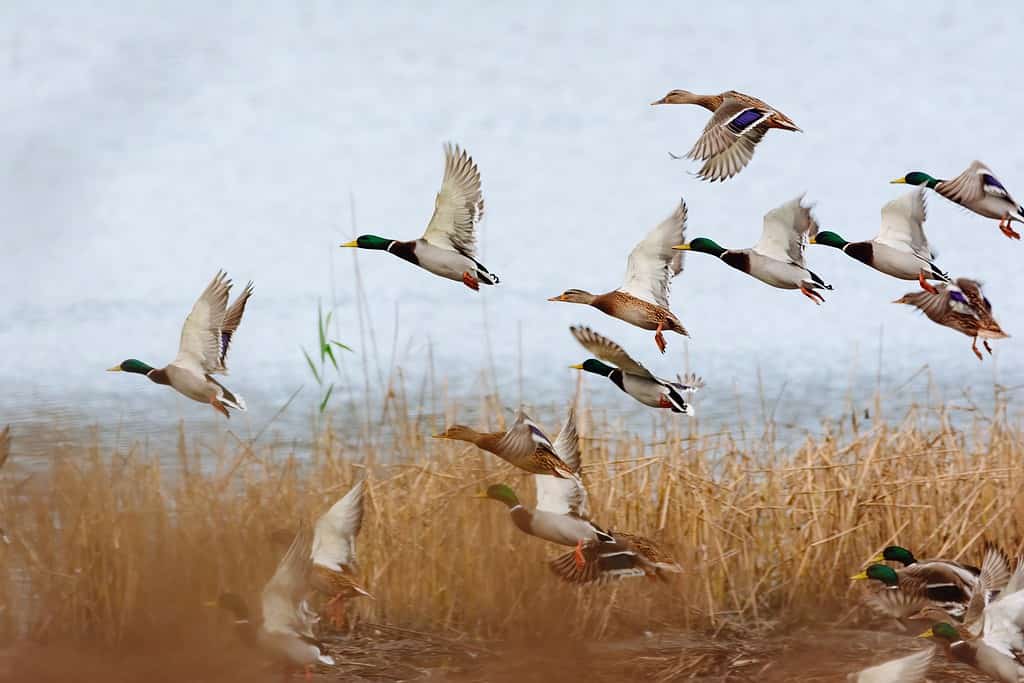
Ducking hunting season is upon us. Protecting these birds from over-harvesting is an important part of conservation efforts. So be sure to practice responsible hunting techniques.
©iStock.com/Thomas_Zsebok_Images
Where Can You Hunt Ducks in Utah?
The following are some of Utah’s prime duck-hunting destinations:
1. Escalante Ranch
Nestled in Jensen, near the iconic Dinosaur National Monument, Escalante Ranch is a popular spot for duck hunting. It provides lodging for hunters, prioritizing essential amenities like TVs, dryers, washers, comfy beds, and spacious living areas.
2. Pleasant Valley Hunting Preserve
Myton’s Pleasant Valley Hunting Preserve is another highly-favored duck hunting location in Utah. Its fields, ponds, and nearby waterways have large numbers of ducks and pheasants for hunters to pursue. Moreover, depending on your preferences, they offer experienced guides to set up your hunts on land or in the water.

The duck hunting season in Utah runs from October 1 to January 14 in the state’s northern region and between October 15 and January 28 in the southern zone.
©Steve Oehlenschlager/Shutterstock.com
3. Fish Springs National Wildlife Refuge
Located in Utah’s West Desert, Fish Springs is known for its large waterfowl population. Here, you’ll find many duck species and other types of birds, such as Canada goose goslings, Lewis’s woodpecker, and Harris’s sparrow.
Also, this wildlife refuge requires duck hunters to adhere to the state’s rules governing the activity. Although you can use dogs, the animals are prohibited from entering enclosed areas to retrieve the birds. At the same time, you must remove any hunting material you bring to the site, including blinds, decoys, and all personal items. If an area is off-limits, avoid exploring it, even if you can spot your favorite duck species.
4. Ouray National Wildlife Refuge
The Ouray National Wildlife Refuge in northeastern Utah also allows for quality duck hunting every fall. One of the best zones to discover here is the Leota Bottom, which has ten impoundments with plenty of waterfowl. Other animals to spot in this region are elk, bald eagles, red-tailed hawks, mule deer, pronghorn, and sandhill cranes.
Supposing you long to pursue elk, deer, and moose at this state-run refuge, keep in mind that shed antler hunting is prohibited. Getting caught partaking in it will land you in trouble with the staff. It’s also illegal to collect fossils, animal or plant parts.
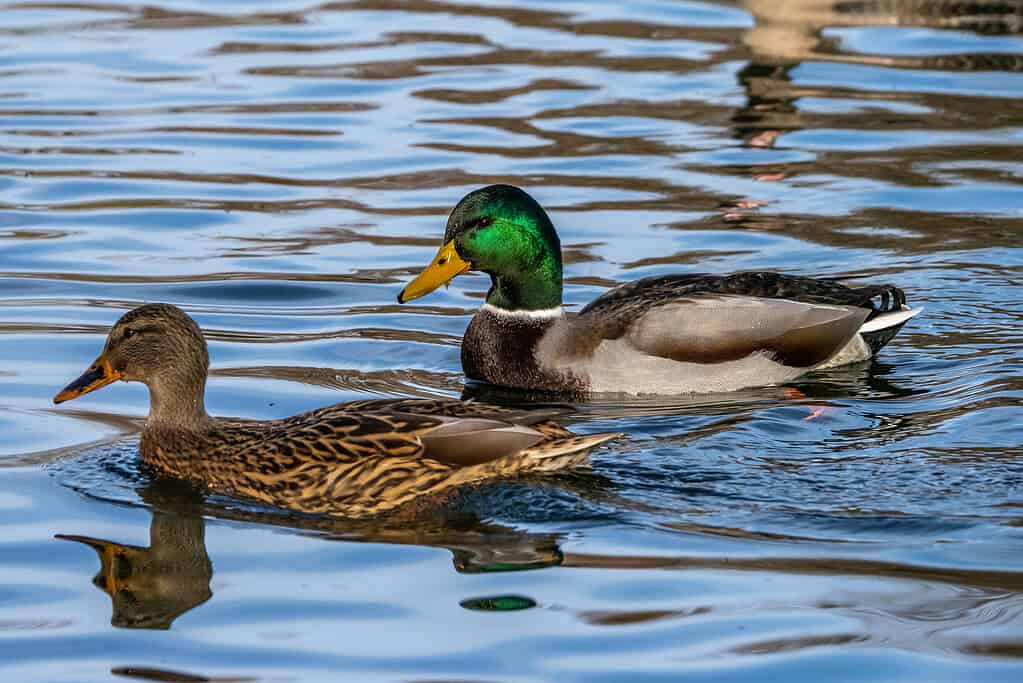
The vast grasslands provide plenty of habitat for numerous species of grassland-nesting ducks, such as mallards, pintails, and gadwalls — making it an ideal spot for duck hunting.
©iStock.com/Rudolf Ernst
5. Bear River Migratory Bird Refuge
The Bear River Migratory Bird Refuge is available when you want to hunt ducks in Utah. Hunters can only enter designated hunt areas that host coots, pheasants, and geese. Learn other rules before coming here to get the most out of your hunting session. For example, shooting within at least 100 years of the roads on site, observation platforms, and parking spaces is prohibited. Violating this law could cut your excursion short.
Utah Duck Hunting Requirements and Rules
You need a Utah Division of Wildlife Resources (DWR) hunting license to hunt ducks in this state. Other necessities are a Harvest Information Program (HIP) number and a federal duck stamp if you’re at least 16.
The DWR offers HIP numbers, but you can get them from trustworthy local agents without visiting its office or website. Although the agency doesn’t provide duck stamps, they’re available at post offices across the state.
Utah doesn’t have age restrictions for duck hunters. However, those aged 13 or younger must be accompanied by adults at least 21. These individuals must have undergone hunter’s education, which requires proof when applying for hunting permits.

Utah is home to a large pool of waterfowl making duck hunting in this state among the most popular sports.
©Moroz Elena/Shutterstock.com
8 Fascinating Ducks Species to Hunt in Utah
Here are eight types of ducks to hunt in Utah:
1. Mallards (Anas platyrhynchos)
Mallards inhabit many parts of Utah, including the saline Great Salt Lake’s marshes. These large dabbling ducks are easily recognizable, thanks to their round heads, long bodies, and broad, flat bills. The males boast a unique colorful plumage in the summer and spring, characterized by yellow bills, bright-green heads and necks, and white rings at the latter’s base. It helps to attract mates during the breeding system.
On the other hand, female mallards boast speckled plumage that serves as camouflage, protecting the species from predators like:
2. Gadwalls (Anas strepera)
Utah also hosts a considerable gadwall population. Although most of these ducks are seen yearly, their sightings increase in November and March-May during migration. Then, and in the winter, you’ll find the birds in fresh and saltwater marshes, ponds, city parks, and the murky edges of estuaries.
Gadwalls are smaller than mallards, and they also have thinner bills. Their bodies are gray, with a noticeable black rear end that reveals a white wing patch during flight. These ducks’ diets primarily comprise aquatic invertebrates and plants, including insects, fish, and amphibians.
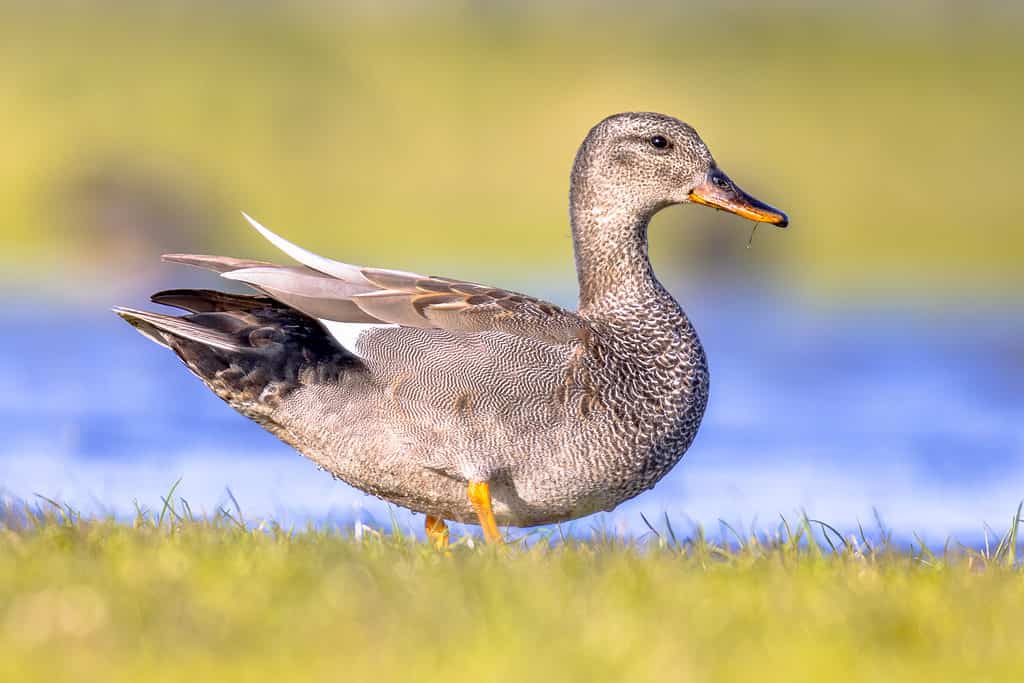
Gadwalls are smaller than mallards, and they also have thinner bills.
©Rudmer Zwerver/Shutterstock.com
3. Northern Pintails (Anas acuta)
You’ll see pintails in northern Utah throughout the year, but they’re winter-only inhabitants of the state’s southern region. Nevertheless, these birds are the epitome of beauty and elegance. Their distinguishing characteristics include small heads, elongated, thin necks, grayish-black bills, slender profiles, and needle-like tail feathers.
Northern pintails live in grasslands, wet meadows, and seasonal grasslands during the breeding season. After it, they migrate to lakes, flooded agricultural fields, bays, saltwater marshes, estuaries, and freshwater wetlands across Utah.
4. American Wigeons (Mareca Americana)
Otherwise known as the baldpate, the American widgeon is another dabbling duck species to hunt in Utah. It has gained a reputation for its upbeat attitude and aggression when competing for food. The latter ranges from aquatic and terrestrial plants like duckweed, cattail, water milfoil, and sedge. Occasionally, these birds also consume the seeds of grass, rice, clover, and barley.
Like several other bird species, American widgeons are fast and easily alarmed, so hunting them can be challenging. They’re year-round residents of northern Utah, but you might have to wait until the winter to see them in the state’s eastern part.
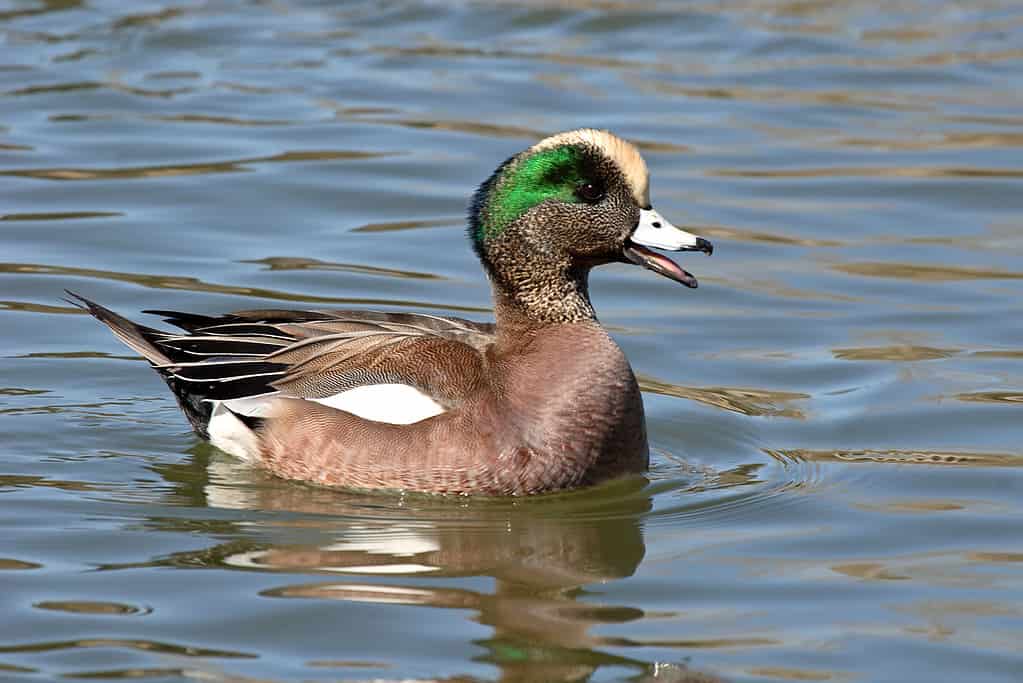
The American wigeon (
Mareca americana) is an ideal bird for hunting, with its large size and distinct white crown making it easy to spot even from a distance.
©iStock.com/gatito33
5. Buffleheads (Bucephala albeola)
The bufflehead is a small, large-headed duck species that nest in Utah’s lakes, small ponds, and rivers. It’s a talented forager which spends nearly half its time underwater hunting for aquatic invertebrates, mollusks, and crustaceans. Even more interesting is that it swallows its food while still in the water, coming up to the surface for only a few seconds before diving back in.
Notably, the bufflehead’s diet depends on its habitat and the season. For instance, in freshwater, they mainly feed on dragonflies and damselfly larvae and large zooplankton like snails — the birds like plants such as pondweeds and bulrushes’ seeds in the winter and fall. The ducks’ diet contains mussels, shrimp, herring eggs, crabs, and ratfish in saline water bodies.
6. Ruddy Ducks (Oxyura jamaicensis)
Compact, large-tailed, thick-necked, ruddy ducks are certainly among the most interesting waterfowl species to hunt in Utah. Their most distinguishing trait is the blue bill resulting from structural coloration. Moreover, they’re more aggressive than other ducks, sometimes even driving rabbits out of their habitats.
The males are extremely bold during the breeding season as they beat their unique bills against their necks to attract the females. But despite their dauntless attitude, they cower in the presence of their predators, which include grebes and American coots.

The ruddy duck (
Oxyura jamaicensis) has a distinct blue bill and is a popular game bird for hunting in Utah.
©iStock.com/Karel Bock
7. Common Goldeneye (Bucephala clangula)
The common goldeneye comes with a small, narrow bill. Adult males have bright-yellow eyes and black heads with round white patches near the latter. On the contrary, the females boast chocolate-brown heads, gray wings and backs, and pale-yellow to white eyes. But both genders’ eyes turn to green-blue as they age.
Goldeneyes have impeccable diving skills, enhanced by their short tails and streamlined bodies. They enjoy eating fish and aquatic invertebrates but sometimes don’t mind salmon eggs, insects, and vegetation. Apart from humans, these ducks’ predators include hawks, eagles, raccoons, and owls.
8. Canvasback (Aythya valisineria)
Hunting canvasbacks is also prevalent in Utah. As many hunters can concur, these ducks are incredibly fast in the sky, boasting up to 72 mph speeds. But on land, they’re clumsy and slow, making it easier to shoot them. While the males have chestnut heads and red eyes, the females feature black eyes and brown heads; both sexes have long bills that give them a distinctive sloping profile.
The canvasback is North America’s largest duck, with a length of about 20 to 21 inches and a 31-25 inch wingspan. The bird spends most of its days floating in the water, even while sleeping, and rarely goes ashore; that’s why its diet is mainly the seeds, leaves, and stems of aquatic plants like sedges, pondweeds, and wild celery. Most of them also like the occasional fish, insects, and mollusks.
Up Your Duck Hunting Skills with Our 3 Insider Tips
Leverage these tips to improve your waterfowl hunting skills as you await Utah’s duck season:
Observe Ducks
Ducks are fascinating birds. But if you know nothing about them, the hunting season might not be as exciting as anticipated. We recommend that you study them to grasp their behaviors or patterns. Start by answering these questions:
- Do all duck species congregate in their habitats?
- When do ducks eat aquatic plants and shift to grains and seeds?
- When do their plumage colors change?
- Where do migratory ducks move to in the winter?
- Which water depths do diver ducks like?
- When and how do ducks breed?
Having this information up your sleeves enables you to develop an effective hunting strategy to hunt certain duck species. For instance, breeding behavior can help you choose the right decoys, and knowing where the waterfowl lives or spends its days allows you to pick the best locations.
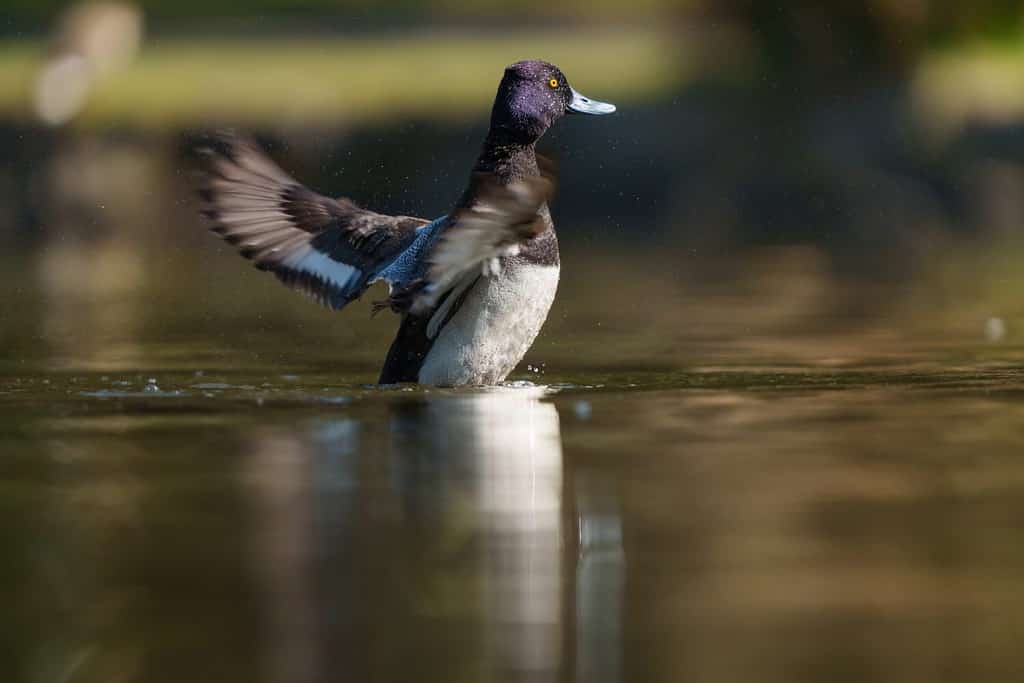
Hunting ducks can be a rewarding experience. To have a successful hunt, it’s important to arrive at your hunting spot before sunrise and use camouflage to blend in with the environment.
©2009fotofriends/Shutterstock.com
Hone Your Shooting Skills
The most experienced and successful duck hunters will tell you that your hunting skills are only as perfect as your shooting capabilities. That’s why you shouldn’t store away your shotgun as soon as the duck season ends. Instead, practice one or two times a week. Try to bring the weapon up as smoothly as possible so that you won’t experience any problems aiming or targeting your game when the time is right.
If you don’t have enough time to shoot regularly, sharpen your pre-mounting, mounting, and swinging skills. By the time the waterfowl season arrives, you’ll be in excellent shape to harvest the birds.
Explore Potential Hunting Areas
Scouting for the best duck hunting areas should be a year-round activity. You want to know the best locations for this thrilling pursuit before the season to maximize your chances of success. This also enables you to make travel arrangements and acquire the required permits in advance. For instance, suppose you want to hunt ducks at the Escalante Ranch, find out the amount they charge hunters and pay in good time to avoid missing a chance.
At the same time, don’t think twice about exploring new hunting zones, as they might offer more unique hunting experiences. Explore those hard-to-reach marshes and creek openings. Discover the ins and outs of various water bodies to know where to find these beautiful birds. Take morning and evening walks in new locations to know where they nest. Having a list of hunting areas to explore saves you time during the duck hunting season since you already know the spots to visit. Ultimately, this allows you to enjoy the activity and harvest more waterfowl.
Make the Most of Duck Hunting Season in Utah
Hopefully, our comprehensive guide has enlightened you about duck hunting in Utah, preparing you for the upcoming season. Given the many locations to hunt these animals, you’re in for a lot of fun. We recommend you invest in the proper gear ahead of time so that nothing comes in the way of you and the limitless thrill you yearn for. This should include decoys, ammunition, guns, duck straps, and blind bags.
Waterfowling is a social venture. Pursuing these species with friends or groups allows you to learn, share memorable moments, and even shoot more birds. But if you’re still more interested in solo courses, take advantage of the time to explore new spots, appreciate the natural world, and relish your own company.
The photo featured at the top of this post is © Wirestock Creators/Shutterstock.com
Thank you for reading! Have some feedback for us? Contact the AZ Animals editorial team.






